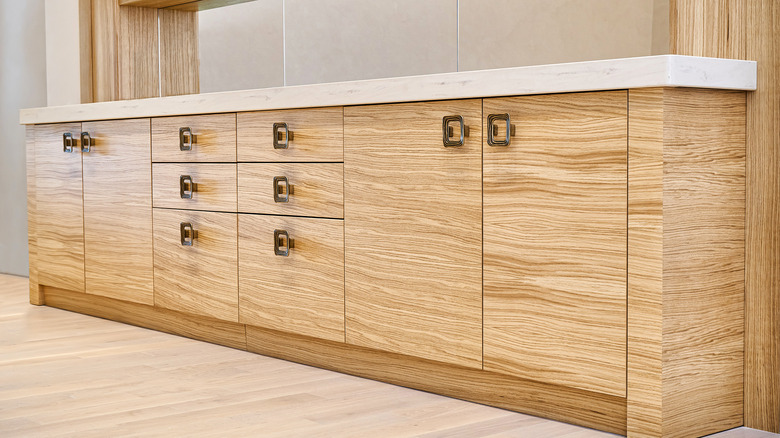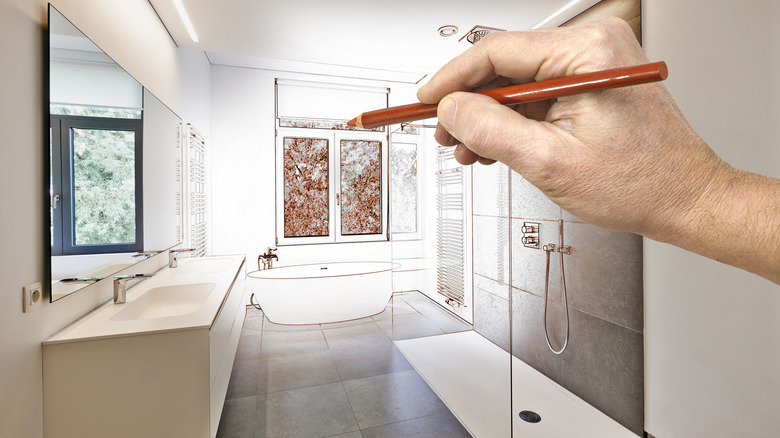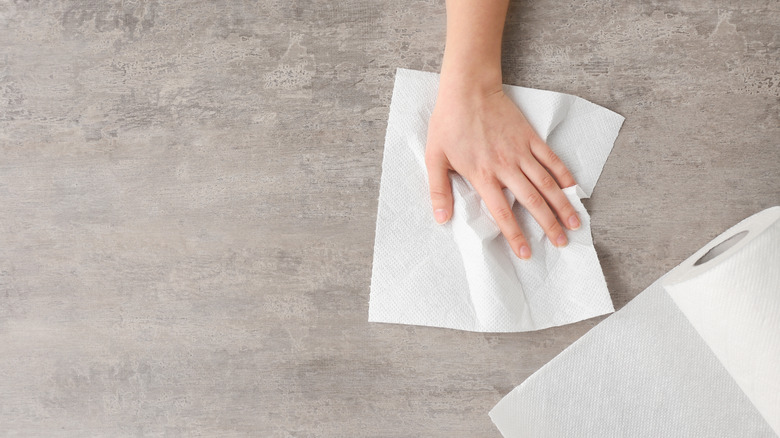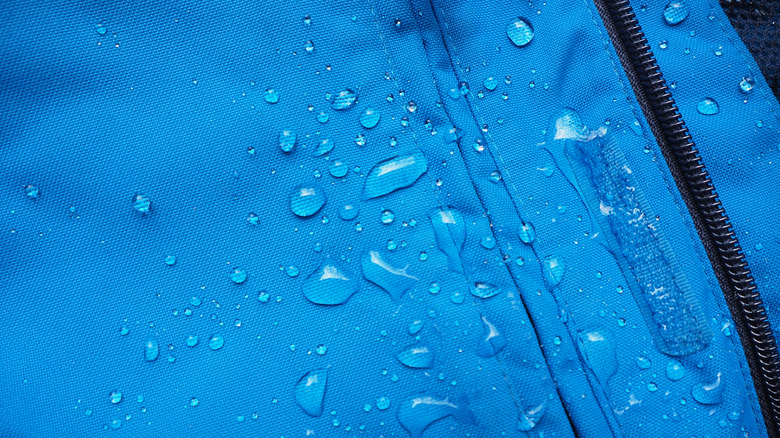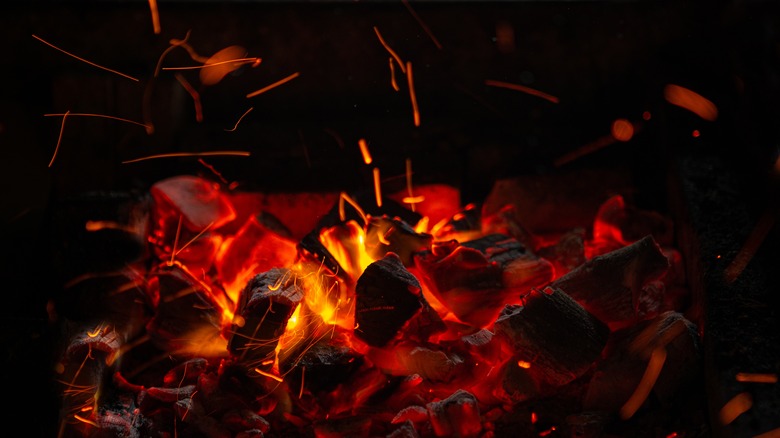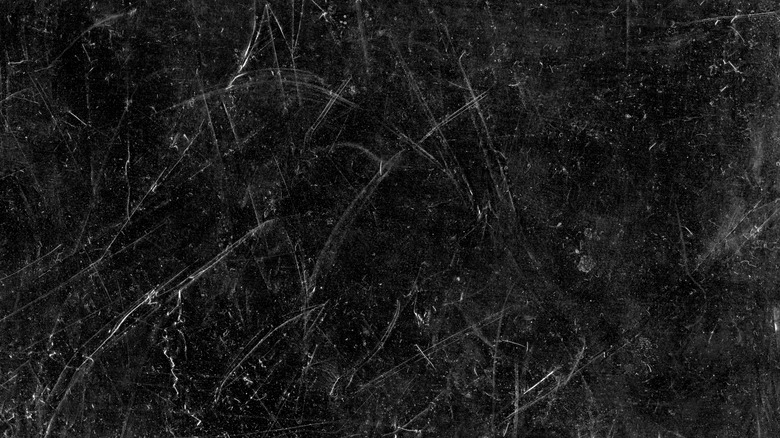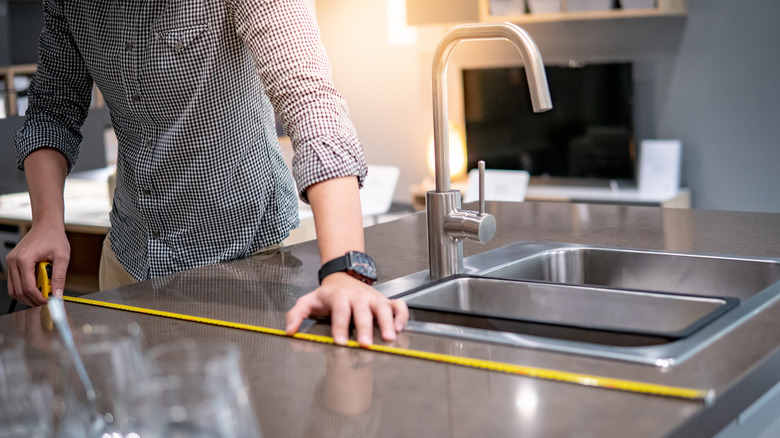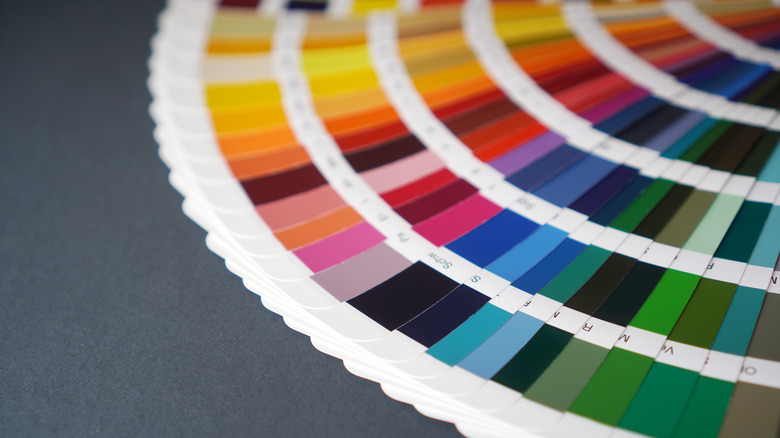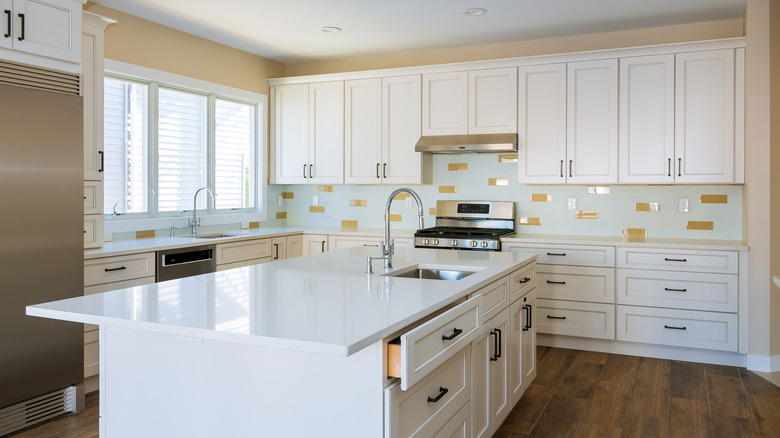Solid Surface Countertops: What To Know Before You Buy
When installing a new kitchen countertop homeowners will become intimately familiar with a number of unique options for the project. From granite and marble to laminate or even quartz countertops, a wide range of surface construction and styles are available. One option that homeowners are often found contemplating is the use of a solid surface countertop. Solid surface countertops were first created in 1967 by DuPont, according to Architizer, just a few short years after the material was first conceived. The solid surface countertop has become a mainstay in the home improvement world, and it can be seen in budget homes and luxury properties alike.
There are a great many benefits that solid surface countertops bring to bear, and homeowners often love the versatility and availability of this type of counter option. Of course, there are some drawbacks but in the grand scheme of things, solid surface countertops offer a resounding value to homeowners of all types. Typically, when purchasing a solid surface countertop, you will install a virtually seamless piece that extends across your counter space. This is a major draw for many homeowners and with the help of a skilled installer or craftsman, it's simple to achieve this one-piece design aesthetic. Solid surface is a great option for many homeowners, and with these key features in mind, you can make an informed decision about whether it's right for you.
History of the solid surface
Solid surface countertops were first introduced to the marketplace in 1964. The product was developed by DuPont and branded with the name Corian. Solid surface material is a combination of acrylic or polyester resin combined with filler material, acrylic chips, and coloring agents to produce a single continuous slab (via Solid Surface). For fabricators, this material is easy to produce and can be worked into a variety of different shapes and sizes with ease.
Solid surface countertops were sold under this moniker for many years, after receiving the patent for this surface fabrication process in 1968. DuPont maintained dominance in this material until the patent expired (20 years, typically, according to Justia, and the same in this instance); Elite Publishing notes that two decades later, in 1989, four other competitors had already entered the market within months of the patent expiration.
In the years since, many other brands have started fabricating and marketing their own version of the solid surface. They have each developed their own formulation process (to add new features or a unique spin to the product) and a wide range of color options, bringing a wealth of options to the marketplace for consumers to choose from. Today, solid surface fabrication is used in a large number of different home improvement applications. It can be found in the shower, on signs, and in external building cladding, according to Solid Surface. The modern homeowner can take advantage of innumerable shape and color options when it comes to installing a new countertop or for use in a variety of other home improvement projects that require the kinds of benefits that this material has to offer.
Solid surface counters are non-porous, and therefore are indeed solid
Perhaps the most important feature of a solid surface countertop is the fact that it is indeed solid. Specifically, a solid surface countertop is nonporous, meaning it will remain impervious to internal cracking and moisture retention that can destroy or damage a marble or quartz slab counter. These surfaces can't be penetrated by air or water, and therefore internal pooling issues simply don't exist (via Kitchen Magic). This makes solid surface counters a reliable installation in any home environment. This is also the feature that makes them a great addition as walling devices or graded flooring units inside showers and bathrooms.
Solid surface counters are poured as a single slab and when looked at in cross-section it's easy to tell why this material retains such low porosity. While no surface can be entirely nonporous, the solid surface creates a single, dense unit of material throughout the construction. Other countertop materials such as quartz or granite consist of tightly packed layers, whose byproduct creates the unique texture that runs throughout these counter types. What provides the visual appeal of the granite countertop or marble installation also creates a weakness in the counter's structural integrity. These layers, while highly durable, can be stretched to their limits under the right circumstances. If standing water is allowed to sit on a quartz or marble surface for long enough, it can seep into these tiny cracks and begin to develop a cleavage within the sheet itself. Solid surface doesn't suffer from this same vulnerability because it is constructed of one continuous layer from top to bottom and edge to edge.
The countertop's extreme moisture resistance makes it a uniquely hygienic option
Solid surface construction not only reduces or altogether eliminates the chance of breakage or significant structural failure, but it also provides an immensely hygienic kitchen addition to any home. Nonporous material is naturally better at combating the establishment and growth of bacteria. Because standing water has nowhere to penetrate, your kitchen counter remains protected against hidden threats to your safety and security.
Because of this added hygiene facet of the solid surface counter, restaurants and professional kitchens of all types often make use of this material (via Shield Casework). Not only is the solid surface counter often cheaper than many of the other high-end alternatives, but the material also performs fantastically in high-pressure environments that require cleanliness, easy cleaning, and a significant longevity factor.
This set of features makes the solid surface worktop a favorite in professional spaces and across the landscape of typical homeownership alike. Just as no professional chef can afford to introduce or foster bacterial or viral growth in their kitchen, a homeowner must work diligently to ensure that the property remains a clean and safe environment. Solid surface countertops can be a fantastic asset in this fight to maintain a clean and beautiful home.
Solid surface countertops do not react well to intense heat
One major drawback of the solid surface countertop is its weakness when it comes to heat. Targeted heat can be used to form solid surface material into rounded edges and other shapes for use in bathrooms and other applications, but this material is also prone to scorching as high heat is added directly to its face. This means that no hot pans can be placed directly on a solid surface countertop, whereas granite and other hard rock options provide this benefit to homeowners.
Slight warping and discoloration can be seen in a solid surface countertop that's been exposed to an open flame, a heated pan, or other sources of heat. This means that a homeowner who often places hot items on their countertop might want to think about either their typical cooking routine or use a different type of material for their kitchen renovation. Deformation can occur at temperatures that rise above roughly 250 degrees Fahrenheit (via Marble Concepts), so placing pans directly from the stove or those that have been recently washed on this surface can be disastrous for a homeowner with a new solid surface countertop.
Scratches are easy to dig into a solid surface countertop
In addition to the scorch problem that solid surface material has, it's also important to note that solid surface material is naturally softer than other hard rock options. While it is possible to use a granite countertop directly as a cutting board (although ill-advised, for many obvious reasons), you will need to be more careful when cutting or placing hard objects on a solid surface countertop. This material is not scratch resistant and will easily pick up scuffs and scrapes if you aren't careful (via Eastern Surfaces). It can be immensely disheartening for a homeowner to install a new countertop and then begin damaging the new addition out of carelessness or by accident. Therefore, if you are thinking about using a solid surface counter then you'll need to understand this weakness inherent to its design.
As with just about any other material that homeowners can use in their renovations, solid surface counters bring an immense wealth of benefits to the kitchen. Yet there are some obvious flaws that must be addressed and understood in order to get the most out of this installation. Simply put, solid surface material is much softer than some of the other options out there in the world of countertop construction. This can be a deal breaker for some or simply a relevant fact for others.
Repairs are easy for the average homeowner
Fortunately, even as solid surface countertops can be damaged by heat or scratching much easier than other materials, repairs are straightforward. Maintaining a high-quality solid surface countertop will require you to be actively involved in the cycle of inspection and repair.
The most common type of damage that you'll see with your solid surface counter is a standard surface scratch. Repairing scratches is as simple as sanding and buffing the counter. One of the primary benefits of the solid surface counter is that sanding is simple and won't require you to dig through multiple layers of finishing or resin exterior in order to get to the actual repair process. Sanding and buffing can be done with an electric sander or a standard set of medium and fine-grit sandpaper sheets. If your counter has experienced a significant amount of scratching recently, then sanding and repolishing the surface is a good idea. This will give you a fresh-looking counter that is ready for action once again.
Solid surface countertops can also crack under heat or pressure. Unlike a granite or marble countertop, the solid surface countertop can be repaired if it has developed a crack without the help of a professional. This might be a revolutionary development for some homeowners who have always had to rely on expensive professional technicians to repair these kinds of damages to their property. The truth is that solid surface material is durable and remedies for damage to the material are typically easy to enact all on your own. Houseopedia suggests using an ice pack to chill the cracked section of the solid surface countertop. Once the surface is cold you can use a fine brush, or even a toothbrush, to clean the area and prepare it for the fix. Then heat the surface with a hair dryer until the crack recloses itself. Superglue the affected area and allow it to dry for at least a day before sanding the surface to finish the repair.
Color options exist in abundance
One benefit that solid surface countertops have over granite, marble, and other natural stone surfaces is the wealth of options when it comes to color and even texture selection. Because solid surface countertops are manufactured, producers are able to blend any number of different color selections together to create natural swirls that mimic the texture of a stone countertop or a flat color option that matches your home's aesthetic and color scheme. Producers are in abundance, with Solid Surface noting twelve exceptional fabricators to choose from and a whole range of products offered by each.
Homeowners have the option to select any type of look for their solid surface countertop, and this freedom makes the solid surface counter an amazing opportunity for homeowners looking to create a kitchen space that really reflects their own personal style. One of the main draws for a granite or quartz countertop is the uniqueness that the stone brings to bear. There are simply no two slabs of granite that are alike. There's a sense of exclusivity that comes along with this type of installation. Homeowners who have installed a granite slab countertop can look at their feature and know that it's the only one of its kind. Often, these homeowners will see a fabricated counter surface and think that it is simply a cookie-cutter installation that has been used a million times over.
Yet this couldn't be further from the truth. Because of the unique ability to blend a veritable rainbow of colors and an even greater profusion of textures within that color scheme, the solid surface countertop can match any natural stone in terms of uniqueness in any given home. This capability means that homeowners won't have to turn just to the most expensive options on the market in order to install a completely unique surface element in their kitchen. If this is something that's important to you, the solid surface countertop can provide that same element of personalization and unique selection process that comes as a natural part of the stone selection effort.
These counter installations don't typically alter home value one way or the other
It's common for homeowners to consider the change to resale value that any particular home improvement project can provide. Suffice it to say, homeowners typically want to steer clear of improvement projects that take away from the financial value of their property. This might seem like an obvious effort, but many new homeowners don't understand the nuances that go into product selection and may end up incorporating materials and renovation features that take away from the overall value of the property by making the space too personalized and niche for the real estate market more broadly (avoiding these options noted by Money Talk News, is a great idea, for instance).
Solid surface countertops don't suffer from this fatal flaw. A solid surface countertop typically features as a net neutral installation. This makes it solid surface countertop a great addition to a property that will be used as a rental income generator, for instance. House flippers will be looking to incorporate renovation projects that bring the top ROI possible, and those performing critical maintenance on their own homes may seek cost-effective measures that bring comfort and luxury to the property while keeping to a strict budget that won't break the bank. Therefore, solid surface countertops may not be a great option for flippers, but they can serve admirably in a home that you intend to keep for a long time. Solid surface durability is quite good and a homeowner's capacity to select from a huge variety of styles and color choices makes this installation something that could provide immense luxury on a stringent budget.
The solid surface countertop won't typically improve your resale value play a considerable margin, but what it lacks in ROI-infusion it makes up for in a bevy of other ways including longevity, stunning visuals, cleanliness, and much more.
An experienced DIYer can build a solid surface countertop with the raw materials
Solid surface is heavy and can be difficult to work with, but for an experience DIYer, it is certainly possible to install your own solid surface countertop. Working with solid surface material to finish off your kitchen renovation can be immensely rewarding. Any time you successfully complete your own DIY job you can look back on the results for months or years and take pride in the fact that you built the piece of furniture, decoration, or a feature. Finishing off the kitchen renovation is no different.
Extreme How To reports that installing your own solid surface countertop rather than relying on a professional kitchen remodeler can save you between $20 and $30 per square foot. Even for a modest kitchen modernization, this can come out to a significant amount of savings that can be applied elsewhere in the home or within the remodeling project itself. It's a good idea to enlist the help of a few trusted friends or family members while working with your solid surface material. The weight alone can be immensely difficult for a single person to manipulate.
It's also essential to create a template for a space that you'll be building a countertop across. Using cardboard or another easy-to-work-with flat surface will allow you to design and measure accurate finished dimensions of the space that you want to build. Taking your time while cutting the countertops is also necessary. Extreme How To suggests offsetting any corner cuts that you might need to make by a few inches so that your seams can be reduced to a nearly invisible incision across the surface. Then, using a mirror cut technique, make any slices that are required to work the full slab into its final state. Gluing up edges and sliding the finished product into place to secure it to your cabinets is all that's left before honing the edges, cutting out holes for the sink and any other installations that require them, and sanding the surface to create a beautiful luster.
